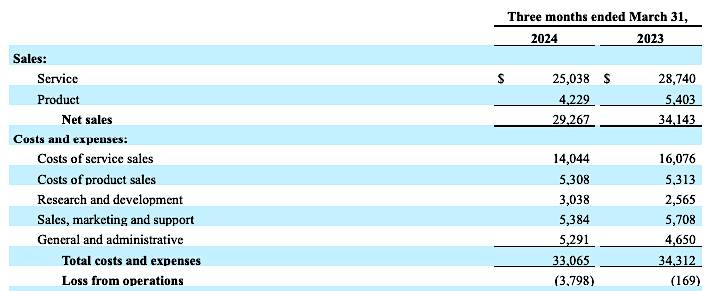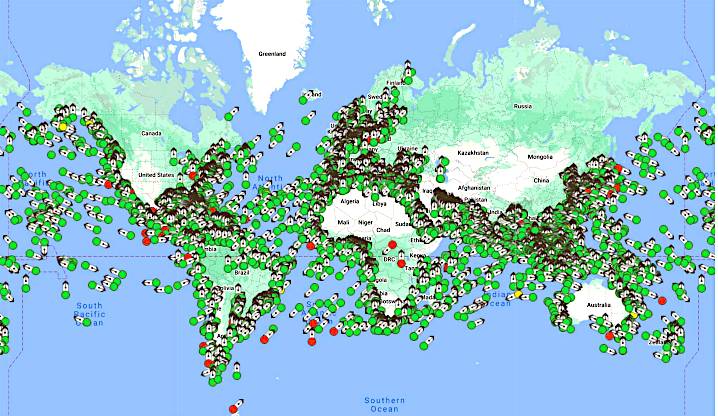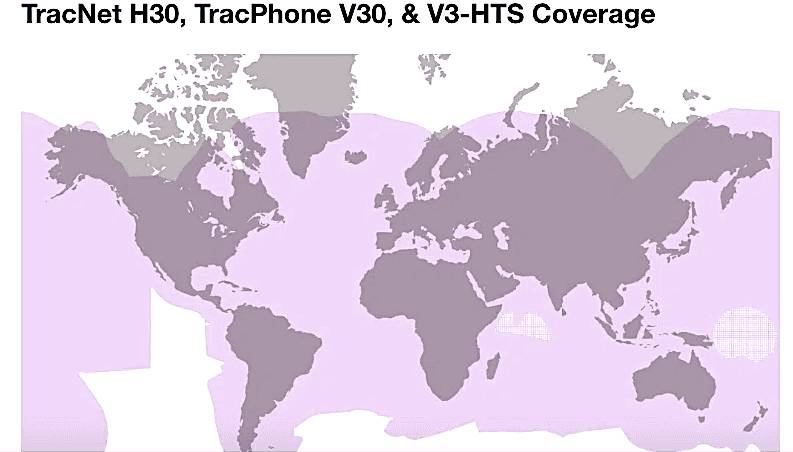 Severance and restructuring charges, the move from GEO-only to LEO or LEO-GEO: KVH said it espects a turnaround to show itself later this year. (Source: KVH Industries)
Severance and restructuring charges, the move from GEO-only to LEO or LEO-GEO: KVH said it espects a turnaround to show itself later this year. (Source: KVH Industries)
LA PLATA, Maryland — Maritime connectivity hardware and service provider KVH Industries said it’s beginning to see positive results from adding SpaceX Starlink broadband service to its portfolio and then bundling KVH’s own add-ons.
The company is navigating a delicate pivot from hardware- to services-based product offering as customers quit geostationary-orbit satellite contracts in favor of a mix of LEO and GEO or LEO alone.
KVH in September became a Starlink reseller and more recently signed a multi-year agreement with OneWeb for maritime capacity. The company’s plan is to reduce, but not eliminate, its global Ku-band GEO-satellite network and provide customers with LEO and GEO as well as 5G/LTE coverage.
KVH earlier this year announced restructuring that includes the closing of a major manufacturing facility dedicated to KVH hardware, cutting staff and refocusing on service provision.
The company has suffered a decline in revenue from one of its largest customers, the U.S. Coast Guard, which has moved from VSAT and GEO-centric connectivity to Starlink.
Rather than continue to compete head to head with Starlink and OneWeb on the terminal side, KVH is focusing on a suite of services it can add onto the LEO bandwidth in the hope of reducing the loss of maritime customers.
In a May 6 investor call, KVH Chief Executive Brent C. Bruun said advertising its Starlink service has brought in customers who would not otherwise have considered KVH.
Under the Starlink agreement, KVH sells raw broadband capacity for those who want only Starlink. A second service bundles Starlink and OneWeb into a multi-orbit offering that includes the GEO VSAT satellite and 5G/LTE.
“Offering Starlink lets us engage with new customers who have never worked with KVH, and to retain customers who might otherwise have left us as they shift their primary communications away from VSAT to these new low-Earth-orbit service,” Bruun said.
He did not provide specific numbers but said the company in the three months ending March 31 doubled its Starlink terminal shipments compared to the previous three months. He also said about half of the new customers coming on opt for the bundled LEO/GEO/5G package rather than Starlink alone.
 (Source: KVH)
(Source: KVH)
KVH’s new CommBox Edge bandwidth-management gateway,“expands the reporting for Starlink data usage and adds management tools not currently available from Starlink,” Bruun said.
Critical to KVH’s future viability will be persuading customers who arrive at KVH because of the buzz around LEO capacity, especially Starlink, to add features that are more profitable for KVH than reselling someone else’s terminals and someone else’s satellite capacity.
“The fastest-growing addition to our portfolio is Starlink,” Bruun said. Demand remains strong. At the same time, we are making excellent progress in integrating OneWeb’s global service into our multi-orbit, multi-network strategy.” KVH expects to begin its commercial OneWeb service by June.
 (Source: KVH)
(Source: KVH)
KVH has a global satellite capacity agreement with Intelsat to access Intelsat’s fleet of Ku-band geostationary satellites. That contract was renegotiated in late 2023 and took effect early this year.
Given Bruun’s remarks about how GEO-orbit Ku-band is viewed in the maritime market, it will be interesting to see how quickly the decline of use of it occurs. Most KVH airtime is still driven by the GEO network, Bruun said, and it offers KVH a high profit margin.
“We expect a slight reduction in our airtime as Starlink becomes a bigger proportion of our overall revenue,” Bruun said. He declined to go into details about the Intelsat contract but suggested that it includes the right to reduce capacity.
“Our contract with Intelsat really mirrors what we anticipate going on in the market, as far as reduction in bandwidth,” Bruun said. “We feel comfortable with how we structured our renewed agreement with them.”
 KVH’s GEO-orbit Ku-band capacity coverage. (Source: KVH)
KVH’s GEO-orbit Ku-band capacity coverage. (Source: KVH)
He said the planned purchase of Intelsat by competitor SES — which he said is “an illustration of the pressure on the GEO market” — will have no effect on the contract or on KVH’s relations with Intelsat.
It’s clear the company believes GEO as a stand-alone is a shrinking business in maritime.
“In light of the intensifying competition that we are seeing from lower-cost LEO satellite service providers, customers are reducing their level of GEO services,” KVH Chief Financial Officer Anthony Pike said during the call. “In consideration of this industry transition and the specific risk factor described, we are reducing our expectations for revenue and adjusted EBITDA in 2024.”
The current forecast is $117-$127 million in 2024 revenue, and between $6 million and $12 million in adjusted EBITDA for the year. The Coast Guard’s contract reduction, now faster than expected, is a factor. That would be an 8% decline from 2023 at the midpoint of the forecast.
KVH reported an operating loss of $3.8 million on revenue of $29.3 million in Q1, down 14% from the same period a year ago on lower product sales and a reduction in the number of vessels it serves. The company is also incurring severance and other restructuring charges that it said will result in $9 million in annual savings.
Vessel count, which stood at 6,700 at Dec. 31, dipped to 6,600 as of March 31.
Bruun said the new Starlink subscriptions, only half of which had been activated as of March 31, “will spur new subscriber growth beginning in the third quarter.”
